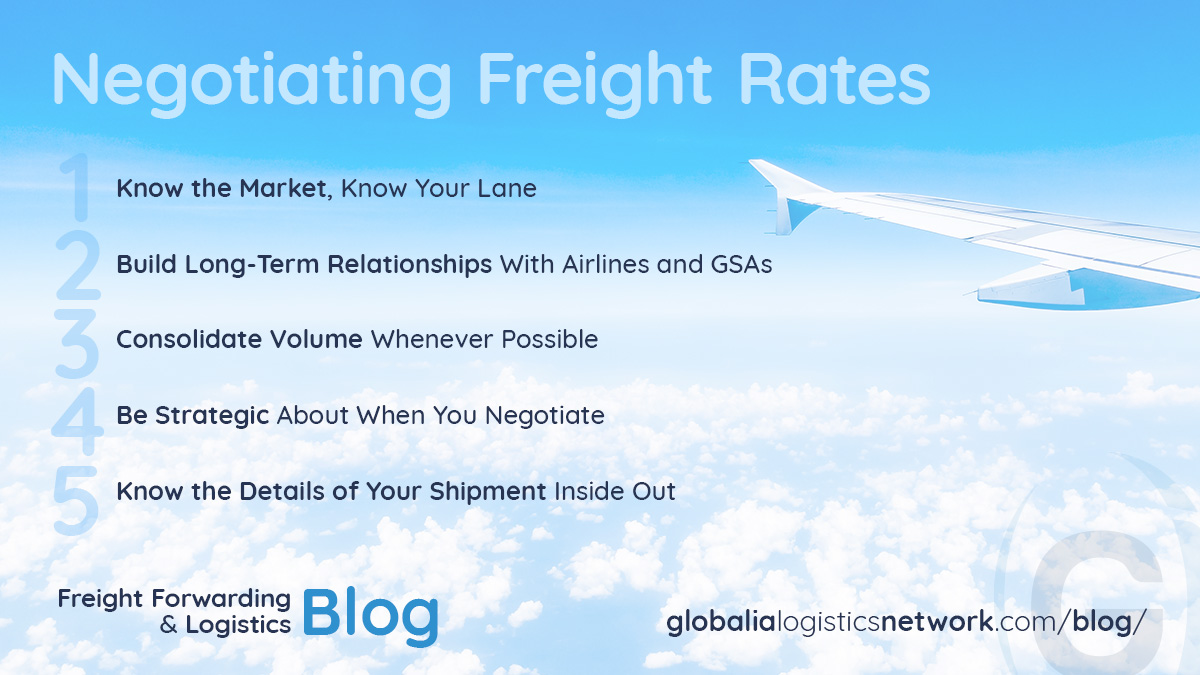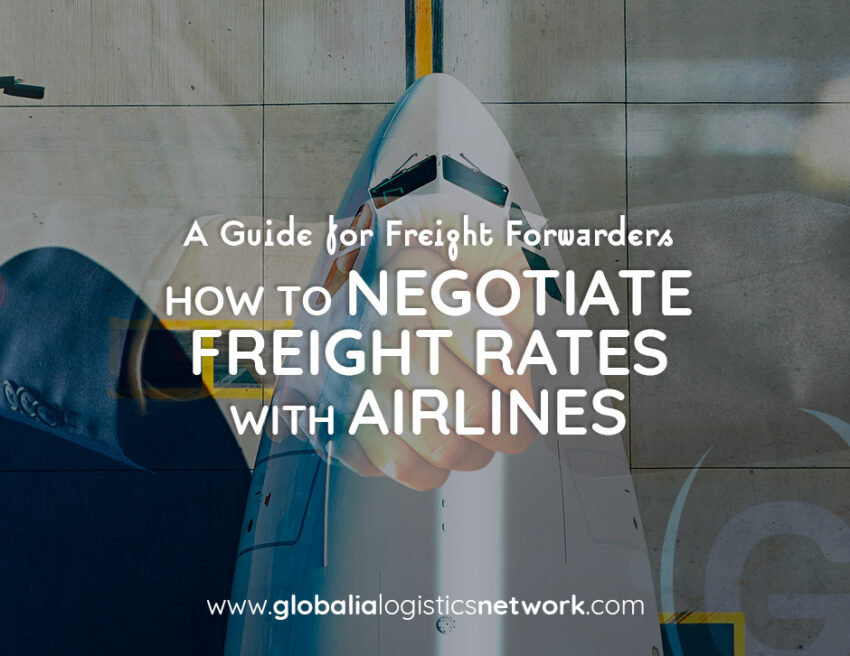Every successful international shipment begins long before the cargo ever leaves the ground. Behind the scenes, freight forwarders are constantly working to secure the right routes, timelines, and—most importantly—costs. When it comes to air freight, where speed and precision are everything, negotiating competitive rates with airlines becomes a crucial part of that equation. Mastering the art of air cargo rate negotiation can give forwarders a powerful edge in a highly competitive and fast-moving logistics environment.
Yet, negotiating better air freight deals isn’t just possible—it’s essential. Your ability to negotiate air freight rates effectively can be the difference between a profitable shipment and one that eats into your margins. More importantly, it’s a key way to deliver value to your clients and secure long-term business.
In this blog, we’ll break down the best strategies and insider tips for freight forwarders looking to improve their air cargo rate negotiation skills. From understanding how airlines price their services to building lasting relationships with carriers, here’s how to fly high in the negotiation game.
Why air freight rates are so complex
Before diving into freight rate negotiation tips, it’s important to understand how air freight pricing works. Unlike ocean freight, which typically involves fewer variables, airline cargo rates are influenced by a complex set of factors. These include the nature of the goods, the chargeable weight (based on volume or actual weight), fuel surcharges, seasonal demand, geopolitical events, and even weather disruptions.
Rates can change weekly—or even daily—especially on popular trade lanes. This volatility is why forwarders must stay informed, agile, and ready to negotiate smartly and quickly.

Step 1: Know the market, know Your lane
Effective air cargo rate negotiation starts with market intelligence. Air freight companies can’t negotiate from a position of strength unless they know what the going rates are, what capacity is available, and what their competitors are offering.
Start by tracking rates on the trade lanes you most frequently operate in. Subscribe to freight rate benchmarking platforms and airline newsletters, and maintain close contact with GSA (General Sales Agents) or cargo sales reps.
If you’re moving shipments between Hong Kong and Frankfurt, for instance, having up-to-date knowledge of that lane’s average rates, transit times, and peak periods gives you a solid base to open negotiations.
Step 2: Build long-term relationships with airlines and GSAs
One of the most overlooked air freight forwarder strategies is relationship building. Rate negotiation isn’t just about one-off deals—it’s about trust, consistency, and mutual benefit.
Get to know your airline cargo reps and GSAs. Communicate regularly, attend industry events, and show a willingness to commit volumes when possible. Airlines are more likely to offer better rates, space priority, or flexible conditions to forwarders they know and trust.
A consistent, loyal customer who ships regular volumes—even if modest—often gets better treatment than a high-volume forwarder who only approaches airlines when the market is tight.
Step 3: Consolidate volume whenever possible
Volume is your greatest leverage. Airlines reserve their best rates for large forwarders or consolidated shipments because they offer efficiency and predictability.
If you’re a small or mid-sized forwarder, you can still benefit by consolidating shipments. Work with co-loaders or partner agents through freight networks to increase your shipment size. The larger the consolidated cargo, the more bargaining power you’ll have.
Some of the best logistics networks offer digital quoting platforms and collaboration tools to help members consolidate shipments and secure better rates collectively.
Step 4: Be Strategic about when you negotiate
Timing is everything in air cargo rate negotiation. Don’t wait until the last minute—airlines typically charge a premium for last-minute bookings, especially during peak seasons.
Whenever possible, negotiate rates in advance. If you expect to move a consistent volume over the coming months, explore setting up block space agreements or rate validity periods. These longer-term agreements provide stability for both parties and can lead to more favorable pricing.
Also, avoid negotiating during global cargo rushes—such as the lead-up to Christmas or major trade shows—when airlines are flooded with demand and have little incentive to lower prices.
Step 5: Know the details of your shipment inside out
Nothing undermines a negotiation faster than vague information. Come prepared with complete shipment details, including dimensions, weights, origin/destination, cargo type, handling requirements, and frequency.
Knowing whether your cargo is general or perishable, hazardous or time-definite, allows you to ask for the right service level—and gives the airline a clearer picture of what they can offer.
More importantly, being well-prepared earns you credibility. Airlines and GSAs are far more responsive to forwarders who are organized and professional in their approach.
Step 6: Negotiate beyond the base rate
A common mistake in negotiating air freight rate scenarios is focusing solely on the base rate. But many extra charges—fuel surcharges, security fees, screening, handling, and documentation—can significantly impact the total cost.
Always request a breakdown of charges and, where possible, negotiate them too. Some airlines may waive or reduce certain surcharges for regular customers, high-volume shipments, or flexible cargo. You can also explore options like deferred service, off-peak departures, or multi-stop routing if your client’s shipment isn’t time-critical. These alternatives can cut costs while still meeting delivery requirements.
Step 7: Use technology to your advantage
Technology can level the playing field in air cargo rate negotiation. Use freight management systems or digital quoting platforms to compare rates across airlines, spot trends, and create cost models.
Some networks, like Globalia Logistics Network, offer members access to tools like FreightViewer, which enables instant air freight quoting. With real-time rate comparisons, forwarders can respond faster to client inquiries and back up their negotiation with hard data. Digital tools also minimize errors and make it easier to communicate clearly with carriers—two things that help smooth the negotiation process.
Step 8: Communicate client expectations clearly
When negotiating with airlines, it’s essential to align their offer with your client’s expectations. Be clear about what’s non-negotiable (e.g., delivery time or cargo integrity) and what’s flexible (e.g., routing, pickup times, or handover points).
This clarity allows the airline to suggest solutions that meet your priorities—whether it’s a cheaper routing option or a premium service with guaranteed space. When expectations are clear from the outset, both sides are more likely to find a workable deal.
Confidence, preparation, and consistency are the key
Negotiating air freight rates isn’t about haggling—it’s about being informed, building trust, and creating value on both sides. As a freight forwarder, you bring expertise, volumes, and opportunities to the table. When you approach airlines with professionalism, clarity, and data, they’ll be more inclined to work with you.
With the right mix of timing, volume, relationship-building, and tech tools, air cargo rate negotiation becomes not just easier, but far more effective. In a market where every dollar counts, mastering the negotiation game could be the key to long-term profitability and stronger client loyalty.


